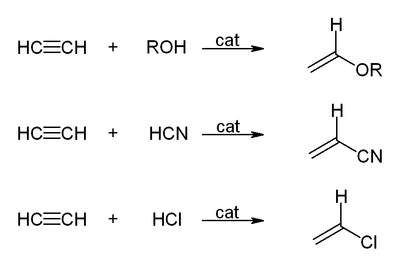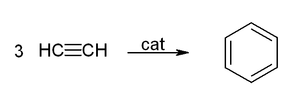Walter Reppe
Walter Reppe (born July 29, 1892 in Göringen , today in Eisenach ; † July 26, 1969 in Heidelberg ) was a German chemist who was a representative of modern process engineering ; he significantly developed the chemistry of acetylene .
Live and act
Beginnings
Walter Reppe began studying natural sciences, particularly chemistry, at the University of Jena in 1911 . During his studies in 1911 he became a member of the Hercynia Jena country team . He had his studies due to the First World War interrupt and then put it in Munich , where he in 1920 by Kurt Heinrich Meyer (1883-1952) with the work about the reduction stages of derivatives of nitric acid to Dr. phil. received his doctorate .
BASF
In 1921 Reppe went to BASF , where he initially worked in the main laboratory. From 1923 he worked there in the indigo laboratory on dye chemistry and the catalytic dehydration of formamide to hydrocyanic acid , developing this process for industrial use. In 1924 he left research to head the solvent and plastics operations in the indigo department for ten years; it was not until 1934 that he returned to chemical-technological research. In 1937 he became an authorized signatory of the company, which was now significantly expanded as IG Farben , in 1938 head of the main laboratory of the IG Farben plant in Ludwigshafen and its director in 1939. In 1942 he was elected a member of the Leopoldina .
Acetylene chemistry
In 1928 Reppe began to work on acetylene , a gas which, because of its willingness to react to syntheses, intruded itself but easily causes explosions for the same reason. Because of this danger, little research was done with the gas and always without the use of high pressures. It was forbidden to compress acetylene above 1.5 at. Reactions with such low pressures, however, did not correspond at all to the traditions at BASF, and no process-technically useful results could be expected. Reppe commented on this in retrospect in 1949: “ It was therefore necessary to break with all traditional views and first of all to study the acetylene decay from the ground up, taking into account the various test conditions, in order to determine suitable safety measures that would also ensure safe work made possible on an industrial scale. “For this purpose, Reppe constructed special test tubes, the so-called“ Reppe glasses ”, which were V2A stainless steel balls with screw caps, which allowed high-pressure reagent tests. The endeavors finally ended with a large number of reactions that could be elegantly combined with one another in terms of process technology and led to the name “Reppe chemistry”. Typically, the “Reppe laboratories” were always on the top floor of the BASF research building.
post war period
After his internment by the Allied occupying powers, Walter Reppe headed research at BASF from 1949 until his retirement in 1957. From 1952 to 1966 he sat on the supervisory board, from 1951 he was honorary professor at the University of Mainz and from 1952 at the TH Darmstadt . He has received numerous prizes and awards, including a. He was awarded the Carl Friedrich Gauß Medal in 1949 , the Great Cross of Merit with Star of the Federal Republic of Germany in 1952 and the DECHEMA Medal, and in 1960 the Siemens Ring .
Reppe chemistry
Reppe chemistry means working with acetylene under increased pressure, heavy metal acetylides (especially copper acetylide) or metal carbonyls and hydrogen carbonyls being used as catalysts. There are four major areas of work:
Vinylation
Ethynylation
Hydrocarboxylation
Here using the example of acrylic acid and acrylic acid ester production:
Cyclization / cyclizing polymerization
Here using the example of benzene and cyclooctatetraene production:
These main reactions result in numerous products, most of which are used for other processes, from which paints, adhesives, injection molding compounds, foams, textile fibers and medicines can ultimately be produced.
Publications (selection)
- Walter Reppe, Otto Schlichting, Karl Klager, Tim Toepel: Cyclizing polymerization of acetylene. I About Cyclooctatetraene . In: Justus Liebig's Annals of Chemistry . tape 560 , no. 1 , 1948, p. 1-92 , doi : 10.1002 / jlac.19485600102 .
- Walter Reppe, Otto Schlichting, Herbert Meister: Cyclizing polymerization of acetylene. II About the hydrocarbons C 10 H 10 , C 12 H 12 and azulene . In: Justus Liebig's Annals of Chemistry . tape 560 , no. 1 , 1948, p. 93-104 , doi : 10.1002 / jlac.19485600103 .
- Walter Reppe, Walter Joachim Schweckendiek: Cyclizing polymerization of acetylene. III Benzene, Benzene Derivatives and Hydroaromatic Compounds . In: Justus Liebig's Annals of Chemistry . tape 560 , no. 1 , 1948, p. 104-116 , doi : 10.1002 / jlac.19485600104 .
- Walter Reppe: New developments in the field of acetylene and carbon monoxide chemistry. Springer, Berlin / Göttingen / Heidelberg 1949.
Honors
A street in the Maxdorf BASF estate was named “Walter-Reppe-Straße” in his honor.
literature
- Susan Becker: Reppe, Walter Julius. In: New German Biography (NDB). Volume 21, Duncker & Humblot, Berlin 2003, ISBN 3-428-11202-4 , p. 440 f. ( Digitized version ).
Web links
- Literature by and about Walter Reppe in the catalog of the German National Library
- Walter Reppe - ring bearer 1960 in the archive of the Werner-von-Siemens-Ring Foundation
- Not a fool right now . In: Der Spiegel . No. 37 , 1948, pp. 5 ( online ).
- Biographies of pioneers in plastics technology: Walter Julius Reppe on plasticker.de
Individual evidence
- ^ Berthold Ohm and Alfred Philipp (eds.): Directory of addresses of the old men of the German Landsmannschaft. Part 1. Hamburg 1932, p. 247.
- ↑ Albert Gossauer: Structure and reactivity of biomolecules . Helvetica Chimica Acta, Zurich, 2006, ISBN 978-3-906390-29-1 , p. 155.
- ↑ Günther Wilke : Organo Transition Metal Compounds as Intermediates in Homogenous Catalytic Reactions (PDF; 390 kB).
| personal data | |
|---|---|
| SURNAME | Reppe, Walter |
| BRIEF DESCRIPTION | German chemist, co-founder of acetylene chemistry |
| DATE OF BIRTH | July 29, 1892 |
| PLACE OF BIRTH | Goering near Eisenach |
| DATE OF DEATH | July 26, 1969 |
| Place of death | Heidelberg |





